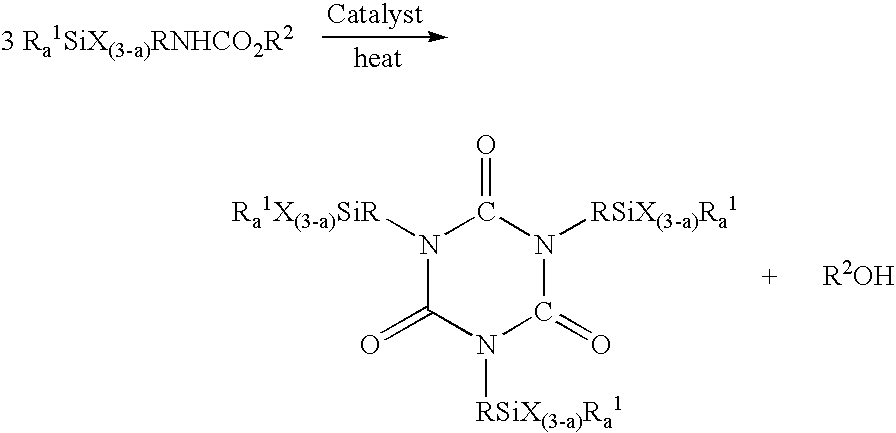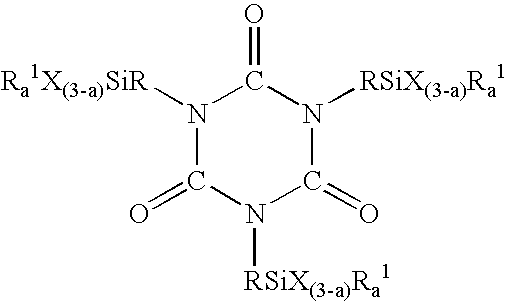Process for making silylisocyanurate
- Summary
- Abstract
- Description
- Claims
- Application Information
AI Technical Summary
Benefits of technology
Problems solved by technology
Method used
Image
Examples
example 1
[0024] To a 2 L 4 necked round bottom flask equipped with overhead stirrer, Vigreaux column, thermocouple and distillation head was added 900 g of previously prepared crude methyl N-3-(trimethoxysilyl)propylcarbamate containing sodium methoxide catalyst used in its production, unreacted dimethylcarbonate and methanol by-product. The reaction medium was neutralized with 1.97 grams of formic acid and briefly agitated resulting in the formation of sodium formate in situ. The solvent pH was measured at 5.9. The mixture was then heated to 130° C. under atmospheric pressure to remove dimethylcarbonate and methanol. The stirred reaction mixture containing the sodium formate formed in situ was then rapidly heated to 210° C. with initial pressure set at 365 mmHg. When the temperature reached 185° C., a sample was removed for measurement of pH, which was 5.6. For comparative purposes, the time when the temperature reached 185° C. was set as T=0. At this time, there was no evidence of reaction...
example 2
[0026] To a 2 L 4 necked round bottom flask equipped with overhead stirrer, Vigreux column, thermocouple, and distillation head was added 900 g of previously prepared crude methyl N-3-(trimethoxysilyl)propylcarbamate containing sodium methoxide catalyst used in its production. This mixture was neutralized with approximately 6 grams of acetic acid and briefly agitated resulting in the formation of sodium acetate in situ. The solvent pH was measured at 6.2. This mixture was then heated to 130° C. under atmospheric pressure to remove the dimethylcarbonate and methanol. The stirred reaction mixture containing the sodium acetate formed in situ was then rapidly heated to 210° C. with initial pressure set at 383 mmHg. At a temperature of 187° C., the pH of the sample was 6.1. No reaction was observed at this time. For comparison purposes, this was set at T=0. After 20 minutes, temperature had reached 206° C. with very little evidence of reaction. The pH of the mixture was 6.4. After 55 min...
example 3
[0029] To a 110 gallon reactor were added 500 lbs of crude methyl N-3-(trimethoxysilyl)propylcarbamate containing sodium methoxide catalyst used in its production and 550 grams of formic acid to produce sodium formate in situ. The mixture containing the sodium formate formed in situ was briefly agitated and the resulting solvent pH was found to be 5.7. After the mixture was stripped of lights at a temperature of 135° C. and atmospheric pressure, the reactor temperature was brought to 210° C. with the initial vacuum at 350 mmHg. The temperature was held at 210° C. while the pressure was reduced at such a rate to keep the differential pressure of the column less than 10 mmHg. After heating for 1.75 hrs, the final pressure was 70 mmHg. With a negligible difference in pressure across the column, the reaction was considered to have been substantially complete. The reaction mixture was cooled to room temperature, and a portion of the mixture was readily pressure filtered through a 5 micro...
PUM
 Login to view more
Login to view more Abstract
Description
Claims
Application Information
 Login to view more
Login to view more - R&D Engineer
- R&D Manager
- IP Professional
- Industry Leading Data Capabilities
- Powerful AI technology
- Patent DNA Extraction
Browse by: Latest US Patents, China's latest patents, Technical Efficacy Thesaurus, Application Domain, Technology Topic.
© 2024 PatSnap. All rights reserved.Legal|Privacy policy|Modern Slavery Act Transparency Statement|Sitemap


